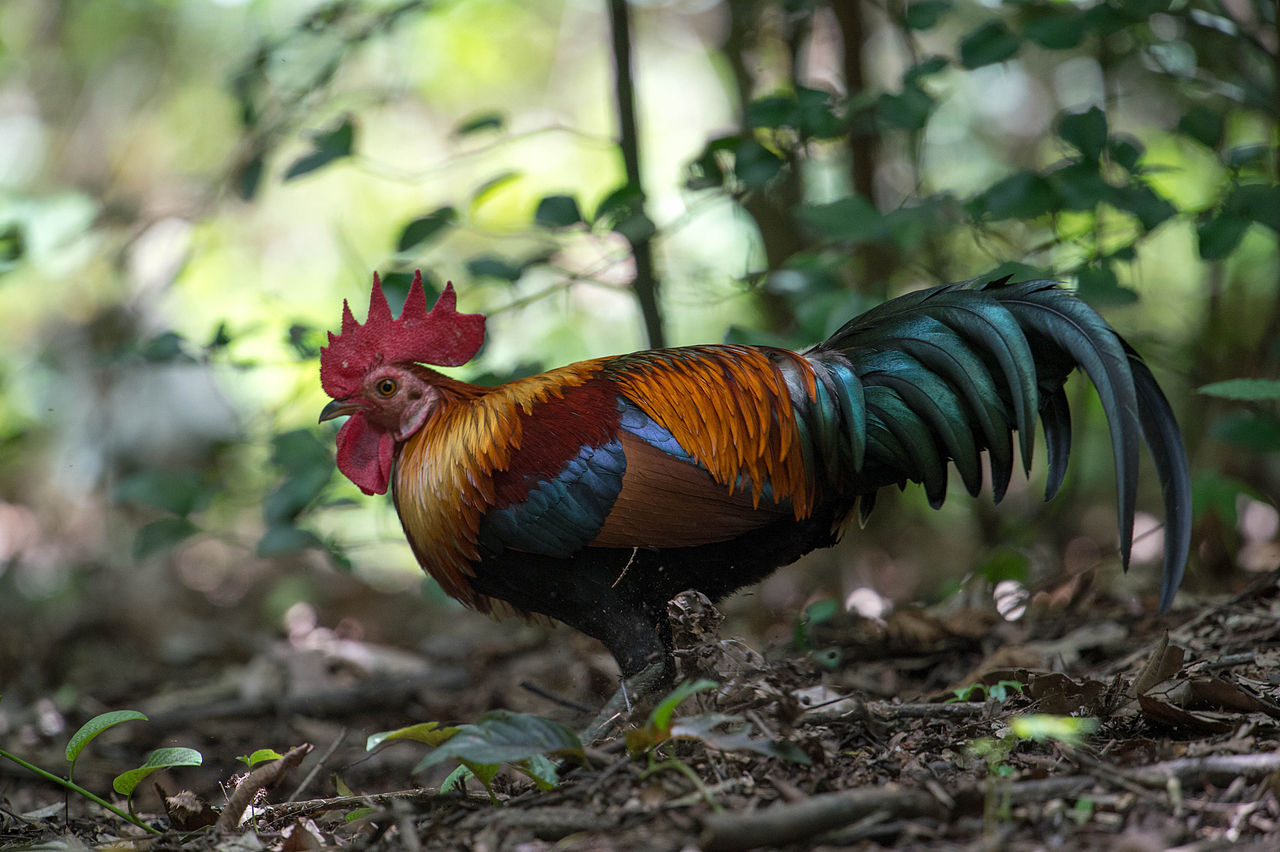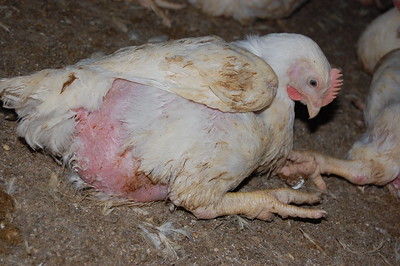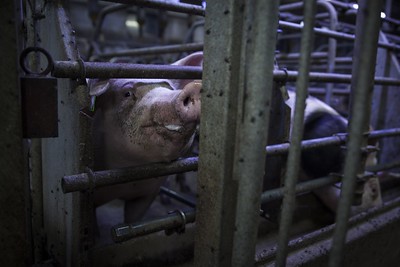
Chickens, pigs, cattle, geese, ducks and other animals suffer immensely in the animal industry – both physically because the breeding and rearing conditions lead to numerous illnesses and injuries, and psychologically because they cannot live out most of their normal behaviour in the standard facilities. They experience extreme restrictions on freedom of movement as well as social stress; their parents or children are taken away and their own needs hardly count at all. The journey to the slaughterhouse and the killing entails even more suffering for many animals.
Below, we will give some examples of how different animals are commonly treated – as a standard, not an exception.
Chickens

Chickens are derived from wild birds that lay 10 to 40 eggs a year for their own reproduction. They hatch the eggs and raise the chicks. Free-range chickens form groups of around 20 hens and one rooster. They spend a lot of time looking for food together. They scrape, peck and scratch the ground and eat seeds, plants, insects and worms. Chickens also perform extensive plumage care, which includes sand bathing and feather cleaning. At twilight, chickens seek a sleeping place as high as possible (see Hoy 2009, chapter on chickens). Modern chickens are the result of targeted breeding. Since chickens are used by humans for two different purposes – meat and egg production – two different types of chickens have been bred. While some put on a lot of meat very quickly, others lay a particularly high number of eggs.“
“Broilers“

“Broiler chickens“ live in modern fattening systems in the tens of thousands in an indoor facility. They are brought into the facility as chicks from the hatchery and reach their slaughter weight there in just under five to six weeks. There are over 20 animals per square metre. The chickens cannot rest undisturbed and cannot pursue their typical behaviours, such as foraging or dusting, let alone act appropriately with one another and maintain social relationships. The barn is only cleaned between the fattening periods, which means that the chickens stand in their own excrement. Foot diseases are the norm; other diseases and ailments caused by turbo fattening and confinement are common (see Livestock Management Report from the Scientific Advisory Board of the BMEL, pp. 96 and 104).
At the end of the fattening period, the chickens are packed into plastic boxes and driven to the slaughterhouse, where they are anaesthetised with gas or in an electric water bath, killed by throat cuts, bled, cut up and further processed.
A three to four per cent loss is normal. This means that a total of well over 50,000 chickens in Germany in a single day die – often painfully – in the fattening systems.
On the day of transportation to the slaughterhouse, so-called catcher convoys or large machines catch and load the broilers. The catchers hold the animals by the legs and carry up to five fattening chickens hanging upside down per hand. In the case of mechanical catching, a system has been established that “sweeps” the animals with rotating rollers onto a conveyor belt. With both methods of catching, animals suffer injuries such as bleeding into the tissue or broken bones of the wings and legs.
“Layer hens“

The purpose of “layer hens” is egg production. Through targeted breeding, the breeding instinct of today‘s farm chickens has been greatly reduced, and the egg yield per chicken increased to over 300 eggs per year. In most large animal factories, the chickens live in caged barn systems, i.e. there are several tens of thousands of chickens in large facilities, some with so-called aviary systems. The permitted stocking density is nine hens per square metre, with several floors having a floor space of 18 per square metre. Above a group size of approximately 50 animals, chickens can no longer build a stable hierarchy; a common consequence of this is behavioural disorders such as feather pecking, which can escalate to cannibalism.
Due to the permanent laying load, the hens often have serious illnesses and injuries. According to a study, an average of 53% of all animals suffer at least one broken bone during their lifetime. (Livestock Farming Report, p. 105).
Hardly any “layer hens“ grow older than about one and a half years. After this time, the laying performance deteriorates and it is most profitable to replace the hens with new ones. The “used“ animals are killed and usually marketed as “soup chickens”. It is also not profitable to raise the male chicks that are produced as part of the “production“ of hens for the egg industry, as they do not lay eggs and are also not suitable for fattening because they do not put on enough meat due to the breeding process. Around 50 million chicks are therefore gassed or shredded every year at just a few days of age.
Pigs
Today‘s pigs are descended from wild boars. Their behaviour is hardly any different from that of their ancestors. They are very active when they have the opportunity. With their sensitive snouts, they rummage for roots, worms and mushrooms in the ground. Pigs are social animals. In their group, they form a hierarchy and close social relationships (see Hoy 2009).
Pigs like to be comfortable, and build sleeping nests out of twigs and leaves. In order to do their business, they move away from lying and feeding places. Sows awaiting piglets remove themselves from their group and build a nest that they keep clean and in which they feed the piglets for 10 days. Pigs are very curious animals and rather clever, communicating with each other using different sounds. They learn numerous commands through trial and error.

In standard animal farming conditions in Germany, pigs spend their entire lives over a few square metres in a barn. A distinction is made between pig-breeding and pig-fattening systems. Sows are kept in breeding facilities and are artificially inseminated twice a year. For insemination, sows can be imprisoned for up to four weeks in body-sized cages, so-called farrowing crates, where they practically cannot move. After the time in the crate, the sows are moved to group pens before they are fixed again in body-sized cages, so-called piglet protection cages, soon before they give birth to their piglets.
The “fattening pigs“ are confined in bays with slatted floors. A bay for 10 pigs only needs to be 7.5 square metres. Here, the animals cannot burrow, wallow or run, cannot seclude themselves, can hardly live out their curiosity and do nothing but eat. A separation of feces from the living area is impossible, so the animals stand and rest on and in their own excrement. In the few months that they are alive, many pigs suffer from infectious diseases and injuries due to the fattening conditions (Livestock Farming Report, p. 96). Animals that die during fattening in the facilities are delivered to processing plants. A study found that up to 1,200 pigs arrive every day in Germany who suffered greatly for a long time before their death.

At around six months of age, the pigs are transported to the slaughterhouse, where they are first anaesthetised and then killed by having their throats slit. Anaesthetic gas feels like suffocation to the animals. According to official estimates, stunning using electrical forceps occurs in 3.3 to 12.5 per cent of cases. In addition, several hundred thousand pigs are not properly “tapped“ each year, so they wake up again in the hot scalding bath where they drown in agony. Overall, the meat industry in Germany kills almost 60 million pigs per year.
– Information about other animal species will follow –
